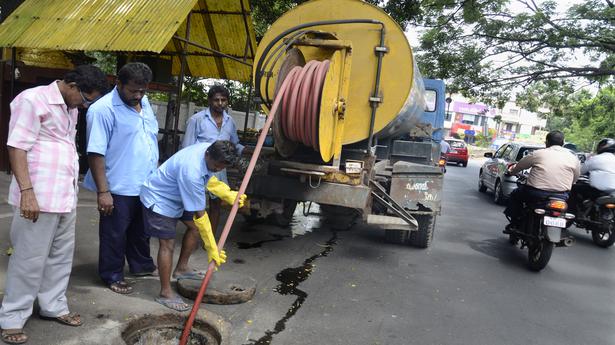
Govt. to enumerate people engaged in hazardous cleaning of septic tanks, sewers
The Hindu
Since 2017, 351 people have died while cleaning septic tanks and sewers, shows data
The Ministry of Social Justice and Empowerment (MoSJ&E) is now preparing to undertake a nationwide survey to enumerate all people engaged in hazardous cleaning of sewers and septic tanks, an activity that has led to at least 351 deaths since 2017. Drawing a distinction between this work and manual scavenging, the Ministry insisted that the practice of manual scavenging no longer takes place in the country as all manual scavengers had been accounted for and enrolled into the rehabilitation scheme.
Ministry officials said that the enumeration exercise, soon to be conducted across 500 AMRUT (Atal Mission for Rejuvenation and Urban Transformation) cities, is part of the Union government’s National Action Plan for Mechanised Sanitation Ecosystem (NAMASTE), which will streamline the process of rehabilitating sanitation workers and eventually merge with and replace the Self-Employment Scheme for the Rehabilitation of Manual Scavengers (SRMS), which was started in 2007.
The NAMASTE scheme is being undertaken jointly by the Ministry of Housing and Urban Affairs and the MoSJ&E and aims to eradicate unsafe sewer and septic tank cleaning practices, said Yogita Swaroop, Senior Economic Advisor in the MoSJ&E, who is overseeing the project.
Officials said that the Ministry’s Standing Finance Committee has already cleared ₹360 crore for this project — to be spent over the next four years.
Parts of this project, already in the works for the past two years, have led to municipal commissioners being declared as the Responsible Sanitation Authorities (RSAs) and Sanitation Response Units (SRUs) being set up in 200 cities, where the national helpline for addressing sanitation needs (14420) has also been operationalised.
Explaining that the enumeration of people engaged in hazardous cleaning of septic tanks and sewers would be the next step, a junior ministry official said that they will now set up Programme Monitoring Units (PMUs) for the 500 AMRUT cities, who will be at the frontlines of carrying out the exercise.
“We have targeted a total of 300 PMUs for this, after which the enumeration exercise is expected to take one year,” the official said, adding that once this exercise is completed across the 500 cities, it will be expanded nationwide, making it easier to bring government benefits like upskilling and loan and capital subsidies to them.













